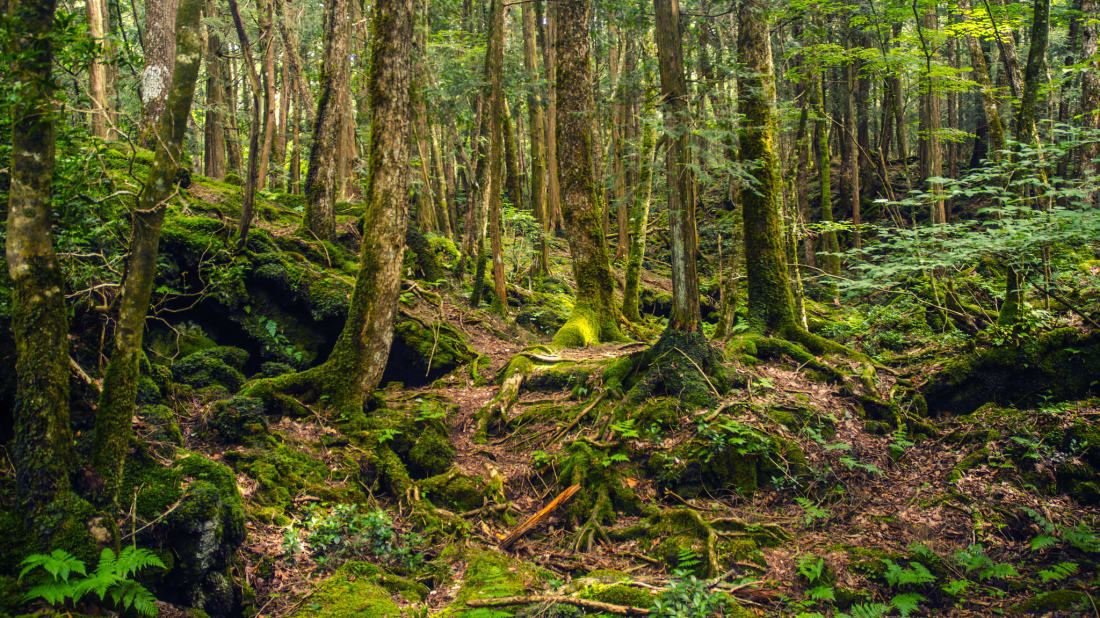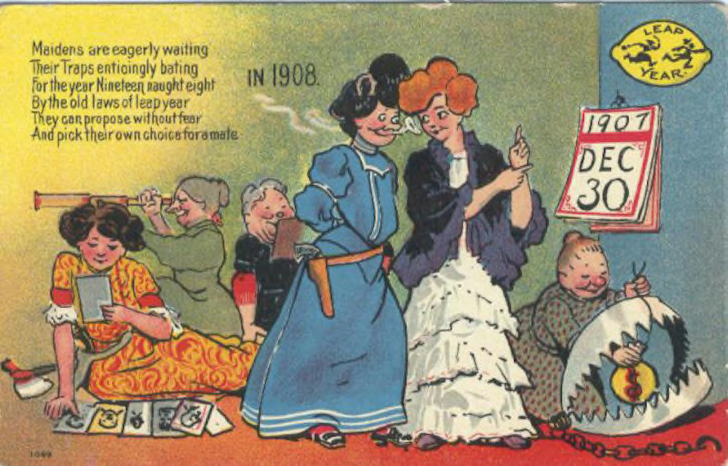Suicide Forest
15 Eerie Things About Japan's Suicide Forest

Northwest of the majestic Mount Fuji is the sprawling 13.5 square miles of Aokigahara, a forest so thick with foliage that it's known as the Sea of Trees. But it's the Japanese landmark's horrific history that made the woods a fitting location for the spooky horror film The Forest. Untold visitors have chosen this place, notoriously called The Suicide Forest, as the setting for their final moments, walking in with no intention of ever walking back out. Here are a few of the terrible truths and scary stories that forged Aokigahara's morbid reputation.
1. AOKIGAHARA IS ONE OF THE MOST POPULAR SUICIDE DESTINATIONS IN THE WORLD.
Statistics on Aokigahara's suicide rates vary, in part because the forest is so lush that some corpses can go undiscovered for years or might be forever lost. However, some estimates claim as many as 100 people a year have successfully killed themselves there.
2. JAPAN HAS A LONG TRADITION OF SUICIDE.
Self-inflicted death doesn't carry the same stigma in this nation as it does in others. Seppuku—a samurai's ritual suicide thought to be honorable—dates back to Japan's feudal era. And while the practice is no longer the norm, it has left a mark. "Vestiges of the seppuku culture can be seen today in the way suicide is viewed as a way of taking responsibility," said Yoshinori Cho, author of Why do People Commit Suicide? and director of the psychiatry department at Teikyo University in Kawasaki, Kanagawa.
3. JAPAN HAS ONE OF THE HIGHEST SUICIDE RATES IN THE WORLD.
The global financial crisis of 2008 made matters worse, resulting in 2,645 recorded suicides in January 2009, a 15 percent increase from the previous year. The numbers reached their peak in March, the end of Japan's financial year. In 2011, the executive director of a suicide prevention hotline told Japan Times, “Callers most frequently cite mental health and family problems as the reason for contemplating suicide. But behind that are other issues, such as financial problems or losing their job.”
4. SUICIDE PREVENTION ATTEMPTS INCLUDE SURVEILLANCE AND POSITIVE POSTS.
Because of the high suicide rate, Japan's government enacted a plan of action that aims to reduce such rates by 20 percent within the next seven years. Part of these measures included posting security cameras at the entrance of the Suicide Forest and increasing patrols. Suicide counselors and police have also posted signs on various paths throughout the forest that offer messages like "Think carefully about your children, your family" and "Your life is a precious gift from your parents."
5. IT'S NATURALLY EERIE.
Bad reputation aside, this is no place for a leisurely stroll. The forest's trees organically twist and turn, their roots winding across the forest floor in treacherous threads. Because of its location at the base of a mountain, the ground is uneven, rocky, and perforated with hundreds of caves. But more jarring than its tricky terrain is the feeling of isolation created from the stillness; the trees are too tightly packed for winds to whip through and the wildlife is sparse. One visitor describedthe silence as "chasms of emptiness." She added, "I cannot emphasize enough the absence of sound. My breath sounded like a roar."
6. DEATH BY HANGING IS THE MOST POPULAR METHOD OF SUICIDE AMONG THE SEA OF TREES.
The second is said to be poisoning, often by drug overdose.
7. A NOVEL POPULARIZED THIS DARK TRADITION. . .
In 1960, Japanese writer Seichō Matsumoto released the tragic novel Kuroi Jukai, in which a heartbroken lover retreats to the Sea of Trees to end her life. This romantic imagery has proved a seminal and sinister influence on Japanese culture. Also, looped into this lore: The Complete Suicide Manual, which dubs Aokigahara "the perfect place to die." The book has been found among the abandoned possessions of various Suicide Forest visitors.
8. BUT IT WAS NOT THE START OF THE FOREST'S DARK LEGACY.
Ubasute is a brutal form of euthanasia that translates roughly to "abandoning the old woman." An uncommon practice—only resorted to in desperate times of famine—where a family would lessen the amount of mouths to feed by leading an elderly relative to a mountain or similarly remote and rough environment to die, not by means of suicide but by dehydration, starvation, or exposure. Some insist this was not a real occurrence, but rather grim folklore. Regardless, stories of the Sea of Trees being a site for such abandonment have long been a part of its mythos.
9. THE SUICIDE FOREST MAY BE HAUNTED.
Some believe the ghosts—or yurei—of those abandoned by ubasute and the mournful spirits of the suicidal linger in the woods. Folklore claims they are vengeful, dedicated to tormenting visitors and luring those that are sad and lost off the path.
10. ANNUAL SEARCHES HAVE BEEN HELD THERE SINCE 1970.
There are volunteers who do patrol the area, making interventional efforts. However, these annual endeavors are not intended to rescue people, but to recover their remains. Police and volunteers trek through the Sea of Trees to bring bodies back to civilization for a proper burial. In recent years, the Japanese government has declined to release the numbers of corpses recovered from these gruesome searches. But in the early 2000s, 70 to 100 were uncovered each year.
11. BRINGING A TENT INTO THE FOREST SUGGESTS DOUBT.
Camping is allowed in the area but visitors who bring a tent with them are believed to be undecided on their suicide attempt. Some will camp for days, debating their fates. People on prevention patrol will gently speak with such campers, entreating them to leave the forest.
12. THE SUICIDE FOREST IS SO THICK THAT SOME VISITORS USE TAPE TO AVOID GETTING LOST.
Volunteers who search the area for bodies and those considering suicide typically mark their way with plastic ribbon that they'll loop around trees in this leafy labyrinth. Otherwise, one could easily lose their bearings after leaving the path and become fatally lost.
13. YOU MAY NOT BE ABLE TO CALL FOR HELP.
Rich with magnetic iron, the soil of the Suicide Forest plays havoc on cellphone service, GPS systems, and even compasses. This is why tape can be so crucial. But some believe this feature is proof of demons in the dark.
14. NOT EVERYONE WHO GOES THERE HAS DEATH ON THEIR AGENDA.
Locals lament that this natural wonder is known first and foremost for its lethal allure. Still, tourists can take in gorgeous views of Mount Fuji and visit highlights like the distinctive lava plateau, 300-year-old trees, and the enchanting Narusawa Ice Cave.
15. GOING OFF THE PATH CAN LEAD TO GHASTLY DISCOVERIES.
The Internet is littered with disturbing images from the Suicide Forest, from abandoned personal effects snared in the undergrowth to human bones and even more grisly remains strewn across the forest floor or dangling from branches. So if you dare to venture into this forbidding forest, do as the signs suggest and stay on the path.
10 Timely Facts About Leap Years

Quick question: What are the chances a given person will be born on February 29, a.k.a. a leap day or leap year day? Depending on who you ask (and what century it is), the odds are either one in 1461 or one in 1506. In short, the answer is complicated—just like a lot of other things about this curious calendar date.
1. JULIUS CAESAR UNDERSTOOD THE NEED FOR LEAP YEARS.

Established in the year 46 BCE, the so-named Julian calendar was devised by Julius Caesar and the Greek astronomer Sosigenes of Alexandria. By this point in history, the traditional Roman calendar had fallen out of sync with the seasons. So at Caesar’s request, Sosigenes reformed it. One of his major changes was the implementation of leap years: Every fourth year, February would receive an extra day. This was meant to keep the new calendar in alignment with the Earth’s position relative to the Sun. Unfortunately, the whole system fell prey to a miscalculation and ended up including too many leap years.
2. THE JULIAN CALENDAR DIDN’T EXACTLY FIX THE LEAP YEAR PROBLEM.
Like many of his contemporaries, Sosigenes believed that each solar year (the amount of time between successive vernal equinoxes) lasted for 365.25 days. Yet this isn’t quite right; as we now know, they last for approximately 365 days, five hours, 48 minutes, and 45 seconds (ie: 365.24219 days) apiece. Over time, the discrepancy spelled trouble. By 1577, the Julian calendar had fallen 10 days out of alignment, meaning important Christian holidays weren't being celebrated on the proper dates. This prompted Pope Gregory XIII to take action. A commission was established to modify the old calendar and upgrade the leap year system. Thus, the new and improved Gregorian calendar was born. It was first implemented in 1582, and we’re still using it today.
3. SOMETIMES, WE SKIP LEAP YEARS.
Under Gregorian calendar rules, certain leap years get skipped. "Century years” like 1700, 1800, and 1900 did not receive leap days, lasting for just the standard 365 days. However, if a given century year is divisible by four, it still gets a leap day, and is thus a bona fide leap year. That’s why 2000 CE was considered a leap year, but the year 2100 CE won’t be.
4. THERE’S A CENTURIES-OLD TRADITION OF WOMEN PROPOSING TO MEN ON LEAP DAYS.
How this whole trend got started is pretty murky. Saint Patrick was rumored to be an early proponent, and there’s a contentious claim that in 1288 Queen Margaret of Scotland—who was only five at the time—legalized a fine for men who turned down a woman’s leap day marriage proposal. Regardless, the custom has a long history in places such as Ireland, where leap day is also called Bachelor’s Day.
5. THERE'S AN HONOR SOCIETY OF LEAP YEAR DAY BABIES FOR PEOPLE BORN ON FEBRUARY 29.
“Membership in the society is free, but is restricted to people born on Leap Year Day,” explains the group’s official website. Launched in 1997, the HSLYDB now boasts more than 11,000 members from all over the world. For many of them, a shared pet peeve is websites that consider February 29 an invalid birth date. The HSLYDB has successfully taken Microsoft and YouTube to task over this very issue. It’s also been fighting to get "leap year day" capitalized in dictionaries and acknowledged on calendars. (That fight is still a work in progress.)
6. FEBRUARY 29 HAS A CONNECTION TO THE SALEM WITCH TRIALS.
February 29, 1692, was a dark day in colonial Massachusetts. That’s when the first arrest warrants were issued for what became known as the Salem Witch Trials. By the end of these paranoia-induced hearings and prosecutions, 20 people were executed.
7. TOYS “R” US ONCE CAME UNDER FIRE FOR IGNORING LEAP YEAR KIDS.
Toys "R" Us invited kids to sign up for personalized birthday cards from store mascot Geoffrey the Giraffe. Sounds cute, right? Well there was a time when leap day babies were left out of the fun due to a programming issue. “How do you explain to a five-year-old that they won’t receive a birthday card from Geoffrey over at Toys "R" Us this year, because the Toys "R" Us computer has no way to recognize their birthday?” asked HSLYDB co-founder Raenell Dawn in 2008. The problem was promptly fixed.
8. RAPPER JA RULE IS A LEAP DAY BABY.

Variously called leapers, leaplings, twenty-niners, and leap day babies (LDBs), people who came into the world on February 29 are in good company. In addition to Ja Rule, these folks share their birthday with baseball great Pepper Martin and former Indian Prime Minister Morarji Desai.
9. A COMMUNITY ON THE TEXAS-NEW MEXICO BORDER CALLS ITSELF THE “LEAP YEAR CAPITAL OF THE WORLD.”
Anthony, Texas and Anthony, New Mexico bookend the dividing line between their respective states. In 1988, local leapers Mary Ann Brown and Birdie Lewis proposed the greater Anthony area should throw a Worldwide Leap Year Festival on their shared birthday—and did so for several more leap years. The parties featured parades, tours, southwestern dancing, and of course, birthday cake. Past shindigs have attracted LDBs from across the globe—along with thousands of other guests. According to the event's website, they're still looking for a 2020 sponsor, so no details have been confirmed.
10. MOVIE HISTORY WAS MADE ON FEBRUARY 29, 1940.
At the 1940 Academy Awards, Hattie McDaniel’s performance as Mammy in Gone with the Wind earned her an Oscar for Best Supporting Actress. She was the first African American to win this particular accolade.
16 Audience Questions About 'The List Show'

It didn’t take long for "The List Show" to become one of our very favorite projects here at Mental Floss. While the hit YouTube series has evolved a bit since it premiered in 2013, we’ve amassed a pretty stellar group of regular viewers who frequently send us ideas for new topics to explore (thanks, guys!) and who have asked us tons of questions about "The List Show" itself. So we decided to get a little meta with the latest edition and answer some of our audience’s most burning questions—like just how many facts have we shared over the years. (You’ll have to watch to find out the answer to that one.)
Join Mental Floss editor-in-chief Erin McCarthy as she answers your questions and reveals some behind-the-scenes facts about "The List Show"—including: What happened to John Green?
For more episodes like this one, be sure to subscribe here!






Comments
Post a Comment